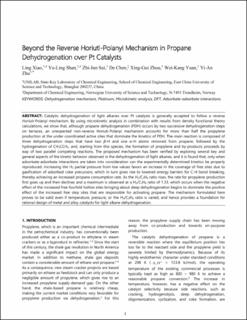| dc.description.abstract | The catalytic dehydrogenation of light alkanes over Pt catalysts is generally accepted to follow a reverse Horiuti–Polanyi mechanism. Using a microkinetic analysis in combination with results from density functional theory calculations, we show that although propane dehydrogenation (PDH) occurs by two successive dehydrogenation steps on terraces, an unexpected non-reverse Horiuti–Polanyi mechanism accounts for more than half the propylene production at the under-coordinated active sites that dominate the kinetics of PDH. The main reaction is composed of three dehydrogenation steps that have two β-H atoms and one α-H atom removed from propane, followed by the hydrogenation of CH3CCH2; starting from this species, the formation of propylene and byproducts proceed by way of two parallel competing reactions. The proposed mechanism has been verified by exploring several key and general aspects of the kinetic behavior observed in the dehydrogenation of light alkanes, and it is found that only when adsorbate–adsorbate interactions are taken into consideration can the experimentally determined kinetics be properly reproduced. Increasing the H2 partial pressure from low values favors an increase in the coverage of free sites due to the gasification of adsorbed coke precursors, which in turn gives rise to lowered energy barriers for C–H bond breaking, thereby achieving an increased propane consumption rate. As the H2/C3H8 ratio increases, the rate of propylene production first goes up and then declines, and a maximum is observed at a H2/C3H8 ratio of 1.33, which occurs when the negative effect of the increased free 4-fold hollow sites that bring about deep dehydrogenation begins to dominate the positive effect of the increased free step sites that are responsible for activating propane. The mechanism formulated here proves to be valid even if the temperature, pressure, or the H2/C3H8 ratio is varied and hence provides a foundation for the rational design of metal and alloy catalysts for light alkane dehydrogenation. | en_US |
